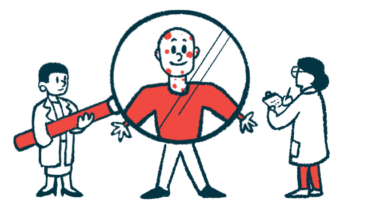New Treatment Candidates Offer Hope for Dravet Syndrome Patients, Review Suggests

Current first-line therapies for Dravet syndrome have limited effectiveness, but treatment candidates now undergoing clinical testing show significant promise, researchers suggest in a recent review.
The study, “Treatment Strategies for Dravet Syndrome,” was published in the journal CNS Drugs.
Accurate diagnosis of Dravet syndrome is possible within the first two years of life, when the child typically presents with one or more prolonged seizures associated with fever or following vaccination. However, common epilepsy medications may aggravate Dravet symptoms, highlighting the need for accurate diagnosis and treatments.
Among the therapies that may worsen symptoms are carbamazepine, oxcarbazepine, phenytoin, and lamotrigine.
Most cases of Dravet syndrome are caused by a mutation in the SCN1A gene. This gene, when healthy, is responsible for generating part of a sodium channel called NaV1.1, which controls sodium’s entry into cells. NaV1.1 is found throughout the brain, but mostly in inhibitory neurons of the hippocampus, neocortex, and cerebellum. Deficiency in NaV1.1 leads to overexcitation and, consequently, seizures.
Patients with Dravet syndrome typically have slowed or halted development, gait impairments in adolescence, and behavioral issues. Parents also report sleep problems and loss of appetite, among other concerns. Growth and hormonal problems are also common.
Because patients show a progressive increase in severity and diversity of seizures, treatment goals vary with age. These goals begin with a focus on avoiding prolonged seizures and status epilepticus – long and/or consecutive seizures without recovery in between — from 0 to 2 years old; shift to minimizing prolonged convulsive seizures and reducing nonconvulsive seizures, which may impair cognition, from 2 to 10 years old; and then decreasing the frequency of nocturnal convulsive seizures in adolescence and adulthood.
Intellectual disability is present in almost all cases by late preschool/early school-age years, making ongoing surveillance and assistance essential. Early intervention, as well as speech, physical, and occupational therapy, are often beneficial. Potential gait and sleep problems should also be monitored, researchers said.
Hyperthermia, or increased body temperature due to failed thermoregulation, is the most common inducer of seizures in Dravet syndrome. Use of antipyretics during infections, as well as avoiding immersion in warm water, intense physical activity, and high ambient temperatures, is recommended. Regular vaccinations are also advised.
As photosensitivity is very common in children with Dravet, avoiding strobe lights and using polarized sunglasses may also help. Addressing sleep problems and allowing the child to nap may limit fatigue, another common complication.
First-line treatments
Current first-line treatment with pharmacological agents consists of valproic acid (sold under brand names Depakote and Epilim) and clobazam (sold under the brand name Onfi in the U.S and Frisium elsewhere). However, rigorous studies on each of these medications in Dravet patients are still necessary. In addition, because these therapies normally only provide modest reductions in seizure frequency and severity, second-line therapies are often used.
Valproic acid acts by elevating the levels of the inhibitory neurotransmitter GABA, and inhibiting sodium and calcium channels. It is usually prescribed at 10-15 mg/kg/day and given two or three times per day, but may later be increased to 25-60 mg/kg/day. This medication may cause serious side effects, including liver toxicity, hyperammonemia — excessive levels of ammonia in the blood — and pancreatitis (inflammation of the pancreas).
Clobazam belongs to a class of medications called benzodiazepines. It activates the GABAA receptor, which similar to valproic acid, increases inhibition of sodium and calcium channels. Clobazam is typically taken twice daily, starting at 0.2–0.3 mg/kg/day, with usual target doses in Dravet of 0.5–2 mg/kg/day. Common side effects include dizziness, drowsiness, sedation, lack of muscle coordination, and increased salivation.
Second-line treatments
Topiramate (Topamax, Janssen) is an antiepileptic medication, which boosts inhibitory nerve transmission and reduces glutamatergic (excitatory) activity, among other effects. This medication is normally given at 1–2 mg/kg/day twice daily, then increased to 8–12 mg/kg/day. Usual side effects include sedation, decreased appetite, and slowed verbal processing.
Stiripentol (Diacomit, Biocodex) is an approved therapy for refractory seizures in Dravet in Europe, Japan, and Canada. It may be available in the U.S. as an investigational new drug. It has a unique structure and binds to a different site of the GABAA receptor than benzodiazepines, leading to a prolonged effect. Add-on use of Diacomit increases levels of valproic acid and clobazam.
Evidence supporting Diacomit’s effectiveness as an add-on therapy in seizure reduction comes from two clinical trials (NCT01533506, NCT02239276), as well as from open-label trials in which all participants took Diacomit. Its usual starting dose is 10–15 mg/kg/day twice daily, with an age-dependent target dose of 20–50 mg/kg/day. Side effects may include somnolence, loss of muscle coordination, anorexia, and weight loss.
Other medications and approaches
Levetiracetam (Keppra) is a novel treatment that acts on several possible biological mechanisms, though researchers are still unsure of their relative contribution to seizure decrease. Among them is the reduced release of neurotransmitters into the synapse, which inhibits neuronal communication. Treatment may start at 14–20 mg/kg/day divided in two doses, increasing to 60 mg/kg/day. Possible side effects include nausea, decreased appetite, moodiness and irritability, poor sleep, and fatigue.
Two other treatment options, bromides and zonisamide (Zonegran) — the second most used Dravet medication in Japan — still have unclear mechanisms of action and drug interactions. Ethosuximide (Zarontin), in turn, still lacks specific data in Dravet patients.
Another alternative is a ketogenic diet, which is a high-fat, low-carbohydrate diet that has long been used for the treatment of epilepsy. Among its possible mechanisms of action is the direct central nervous system effect of ketone bodies, an alternative source of energy to glucose, which may reduce neuronal excitation. The ketogenic diet’s effectiveness in Dravet has been supported in several case series.
Surgical procedures
Electrical stimulation of the vagus nerve, the longest in the involuntary nervous system, which controls internal organs and glands, is an approved add-on therapy for medically intractable epilepsy. This is achieved through a surgically implanted device, which delivers chronic, intermittent stimulation. Reports of its effectiveness suggest a moderate effect on seizure reduction.
Corpus callosotomy, a surgical procedure that interrupts communication between the two brain hemispheres, may also be considered, but current recommendations strongly advise an assessment of its risk/benefit ratio and state it should only be considered after failure with clobazam, valproic acid, Diacomit, Topamax, levetiracetam and ketogenic diet.
Medications in development
Several treatment candidates for Dravet syndrome are now being tested. They include cannabidiol, a cannabis derivative with as-yet unclear mechanisms. Recently, the U.S. Food and Drug Administration granted priority review to a New Drug Application submitted by GW Pharmaceuticals regarding Epidiolex, a treatment candidate with cannabidiol as its active ingredient.
In the CARE1 Phase 3 clinical trial (NCT02091375), a daily dose of 20 mg/kg of Epidiolex in addition to standard anti-epileptic treatment over 14 weeks led to a 39% decrease in patient seizure frequency, compared with 13% in the placebo group. Similar safety results were reported from an open-label study.
Data on the Phase 2 CARE1 trial (NCT02091206) showed Epidiolex was generally well-tolerated by patients, and GW Pharmaceuticals has now launched a Phase 3 trial, CARE2 (NCT02224703), investigating the safety and effectiveness of Epidiolex in children and young adults with Dravet syndrome. The study is currently recruiting approximately 150 participants at sites across the U.S. and Netherlands.
Other potential treatments include fenfluramine (ZX008, Zogenix), currently undergoing Phase 3 testing in the U.S. and Europe, and granted breakthrough therapy designation by the FDA; lorcaserin; clemisole; verapamil; EPX-300 (an FDA-approved anti-depressant, anti-anxiety, and hypnotic medication); TAK-935, developed by Takeda and Ovid Therapeutics and granted orphan drug status in the U.S. for the treatment of Dravet; ataluren, developed as Translarna by PTC Therapeutics for muscular dystrophy; and BIS-001, developed by Biscayne Neurotherapeutics.
Management of status epilepticus
Current management of status epilepticus in Dravet patients is done with home and hospital management. Home management should take into account the patient’s individual characteristics, including types of seizures and prior response to rescue medication, the authors observed. Rectal diazepam and buccal/intranasal midazolam are recommended treatments.
The authors also believe that hospital management should be individualized to enable timely treatment of seizures in the emergency department.
Because there are not clinical trials informing hospital management of Dravet patients, the authors proposed an approach consisting of intravenous administration of a benzodiazepine (lorazepam, diazepam, or midazolam) as a first-line therapy; valproic acid, levetiracetam, or fosphenytoin as second-line treatments, and midazolam drip or propofol as third-line therapies.
“Accurate and early diagnosis leads to an opportunity to provide optimal treatment and potentially improve developmental outcome in this unique population,” the investigators wrote.
“Given that our current first-line agents show only modest efficacy, it is highly likely that one or more of these agents in development will supplant clobazam and valproic acid as first-line treatment, provided safety data continue to be favorable,” they added.







